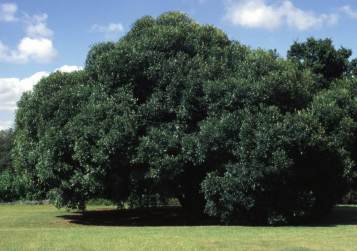Olea europaea subsp. africana
Olea europaea L. subsp. africana (Mill.) P.S.Green
Family: Oleaceae
Common names: wild olive, olienhout (Afr.), mohlware (NSotho, SSotho), umnquma (Zulu, Xhosa, Swati), mutlhwari (Venda), motlhware (Tswana)
SA Tree No: 617
Introduction
Frost-, drought- and wind-resistant, the wild olive has beautiful wood for furniture, and is regarded as a small-fruited subspecies of the commercial olive.

Description
Description
Olea europaea subsp. africana is a neatly shaped evergreen tree with a dense spreading crown (9 x 12 m) of glossy grey-green to dark-green foliage. Leaves are grey-green to dark-green above and greyish below. The rough, grey bark sometimes peels off in strips.

Sprays of tiny, lightly scented white to greenish flowers (October to February) are followed (March to July) by small, spherical, thinly fleshy fruits (either sweet or sour) which ripen purple-black.

Distribution and habitat
Distribution description
This tree is found in a variety of habitats, often near water, e.g.on rocky hillsides, on stream banks and in woodland (where it can reach 12 m). It is widespread in Africa, Mascarene Islands, Arabia, India to China.
Derivation of name and historical aspects
History
The Latin name for olive is olea; europaea = from Europe, and africana = from Africa. There are four species of Olea in South Africa.
Ecology
Ecology
The fruits are popular with people, monkeys, baboons, mongooses, bushpigs, warthogs and birds (e.g. redwinged and pied starlings, Rameron pigeons, African green pigeons, Cape parrots and louries). Leaves are browsed by game and stock. This tree is an asset on farms and game farms, especially in very dry areas because it is extremely hardy and is an excellent fodder tree.
Uses
Use
A tea can be made from the leaves. The hard, heavy and beautiful golden-brown wood is used for furniture, ornaments, spoons and durable fence posts. An ink is made from the juice of the fruit. Traditional remedies prepared from this plant serve as eye lotions and tonics, lower blood pressure, improve kidney function and deal with sore throats. The early Cape settlers used the fruits to treat diarrhoea.

Growing Olea europaea subsp. africana
Grow
Propagate it from seed or from hardwood cuttings. Sow fresh seed in river sand. Treat cuttings with a rooting hormone. The slow-growing frost, drought and wind-resistant wild olive makes a good shade or screen plant in the home garden, on golf courses and elsewhere. It is popular for bonsai, street planting, and for use at schools, office complexes, and in parks. It is perfect for dry areas where it is an excellent fodder plant for stock and game and it has also been used to stabilize erosion dongas/ditches.
Don't plant it too close to walls, patios or swimming pools, the root system can sometimes be aggressive. Always add plenty of compost to the planting area and apply a thick mulch layer (organic material, like dried leaves) to protect the soil surface. Water moderately throughout the year. This tree has a wide distribution in South Africa and grows in both summer and winter rainfall areas. It also occurs in very dry areas, and tolerates temperatures ranging from about - 5°C to 40°C. Once established it is virtually indestructable.
References
- COATES-PALGRAVE, K. 1988. Trees of southern Africa, edn 2. Struik, Cape Town.
- JOFFE, P. 2001. Creative gardening with indigenous plants-a South African guide. Briza Publications, Pretoria.
- PALMER, E. & PITMAN, N. 1972. Trees of southern Africa. Balkema, Cape Town.
- POOLEY, E. 1993. The complete guide to trees of Natal, Zululand and Transkei. Natal Flora Publications Trust.
- VAN WYK, B., VAN OUDTSHOORN, B. & GERICKE, N. 1997. Medicinal plants of South Africa. Briza Publications, Pretoria.
- VAN WYK, B. & VAN WYK, P. 1997. Field guide to the trees of southern Africa. Struik, Cape Town.
- VENTER, F. & VENTER, J. 1996. Making the most of indigenous trees. Briza Publications, Pretoria.
- WATT, J.M. & BREYER-BRANDWIJK, M.G. 1962. The medicinal and poisonous plants of southern and eastern Africa. Livingstone, London.
Credits
Pitta Joffe
Pretoria National Botanical Garden
November 2002
Plant Attributes:
Plant Type: Tree
SA Distribution: Eastern Cape, Free State, Gauteng, KwaZulu-Natal, Limpopo, Mpumalanga, North West, Northern Cape, Western Cape
Soil type: Sandy, Clay, Loam
Flowering season: Spring, Early Summer
PH: Neutral
Flower colour: White
Aspect: Full Sun
Gardening skill: Easy
Special Features:
Horticultural zones











Rate this article
Article well written and informative
Rate this plant
Is this an interesting plant?
Login to add your Comment
Back to topNot registered yet? Click here to register.